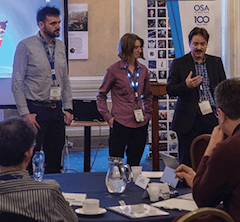One of the joys of attending a conference is not just finding educational content that aligns with your interests, but making connections with others who share them. But what if your interests are so specialized or so far ahead of the curve that no such content — or networking opportunities — exist?
That’s precisely the gap that The Optical Society’s (OSA) five-year-old Incubator program was designed to fill. OSA dedicates six to eight small, two-day meetings each year to topics and fields that don’t appear on the agendas of the more than 40 other meetings it organizes. Incubator topics are “very new and emerging, or are in very niche areas that don’t really have good cover-age in our existing portfolio,” said Marcia Lesky, OSA’s deputy senior director of business development for meetings and conventions. “Often, only a limited number of people are even working in these fields.”

In 2016, OSA held its first Incubator in an international destination — at the Royal Society of Edinburgh.
SUBJECT MATTERS
OSA casts a wide net to identify likely topics for Incubator meetings. Anyone working in optics or a related field can propose one by filling out a form on OSA’s website. “We’ve had both members and nonmembers propose meetings,” Lesky said. Suggestions also come from academia, government agencies, and national labs.
The Incubator meetings are small by their nature and by design, typically attended by 30 to 40 people. To organize them, OSA develops the idea with a “host team,” which usually is made up of a group of two to four people who are experts in the topic area. “Sometimes a proposal comes in with a fully formed host team, and they’re ready to go,” Lesky said. “And sometimes we work with [the host] to identify someone to add to the team that can bring a different perspective.”
Because the topics are unique, every meeting is custom-designed in collaboration with the hosts. The program might include panels, invited speakers, moderated sessions, breakouts — or all of the above. As for who attends, “the hosts, who are the ones really driving these programs, create an invitation list,” Lesky said. “The programs are on our website, and if individuals are interested, they can request an invitation to attend. We usually have a few people that do that, and the hosts almost inevitably say, ‘Of course! Add them to the list.’”
The meetings emphatically are open to OSA members as well as non-members. “In fact,” Lesky said, “because they’re new areas and maybe bring in people from different communities, oftentimes it is a combination of a lot of different folks.”
The expected outcomes of the meetings also vary, depending on their content. Each one is covered in OSA’s member magazine, Optics & Photonics News, on OSA’s website, and occasionally, Lesky said, in another of OSA’s more than a dozen journals. A few of the meetings’ proceedings have been used to create white papers, and a topic might also grow into a larger OSA meeting, as previous Incubator meetings have done.
“Each program is very different,” Lesky said. “We work with each host team to meet their needs and the needs of the topic area in the community.”
INTERNATIONAL ACCESS
Until recently, Incubator meetings were all held at or near OSA’s headquarters in Washington, D.C. This past December, OSA held its first international Incubator meeting, in Scotland — the OSA Future Microscopy Incubator: Merging Adaptive and Computational Imaging, at the Royal Society of Edinburgh. “Today, OSA is the leading optics and photonics convener, unit-ing more than 270,00 scientists and professionals among 177 countries,” Lesky said. “So now that we’ve got this [Incubator] program that seems to be well established, we wanted to make sure that we’re representing all of our members and that everyone was having easier access.”
Making the jump to an international meeting didn’t change any aspect of the program, other than the geographic location, according to Lesky. OSA members who are also members of the U.K.’s Royal Societies helped forge connections.
In fact, making strategic connections is a key aspect of Lesky’s job. Although she’s part of OSA’s meetings and conventions department, “I don’t exactly have a meetings-program back-ground,” she said. “That’s not really what The Optical Society was looking for in my position. Innovation is a driving force at OSA and we typically seek out people who can bring a fresh perspective to what may be deemed a traditional product, such as meetings or scientific journals.”
Lesky earned a master’s degree in environmental science and policy, and has worked in advocacy and outreach positions in environmental and other groups, in addition to running her own strategic-consulting firm. “We’ve got a wonderful meetings team [at OSA] that I work with very often and rely on heavily,” Lesky said. “OSA values strategic thinking, and it’s wonderful to be able to apply my strategic and analytical skills to the development of new ventures and potential new markets.”


